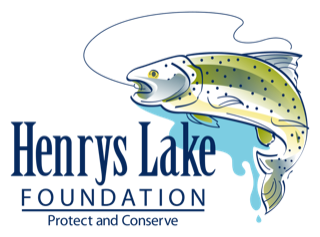The Fish

Fish species other than trout in Henrys Lake include mountain whitefish, mottled sculpin, longnose dace, and speckled dace as native fish. Introduced non-game species include redside shiner and Utah chub. The mountain whitefish population has decreased markedly since the construction of the dam on Henrys Lake. The last confirmed catch was in 1992 and was large, over 3 pounds. Mottled sculpin are common in Henrys Lake, as are both dace species and redside shiner. The Utah chub is the newest introduced non-game fish, first confirmed by Fish and Game Department gill netting in 1993. However, anecdotal information suggests that the Utah chub may have been introduced into Henrys Lake much earlier than that. There is no definitive information in regards to how the Utah chub first became established in Henrys Lake. Redside Shiners were introduced as a supplemental forage fish in the 1940s however they are seldom utilized by other fish species as a food source. They tend to travel in schools and feed primarily on caddis larvae.
The Utah Chub
Little is known of how the Utah chub lives in Henrys Lake. The Utah chub is native to the Bonneville drainage in Nevada but introduced into other western streams. It was found in the Island Park reservoir shortly after the dam was constructed and has flourished there. Periodic rotenone treatments have been ineffective and catch rates of trout did not increase significantly following these treatments. In Hebgen Lake male chubs reach sexual maturity at age three and females at age four. Spawning occurs from June to Mid July with a few spawning in May and early August. Spawning takes place in 30 to 120 cm of water near shore in vegetated areas. The Utah chub is a shoreline spawner and does not access the tributaries to spawn like the trout species. The Utah chub is a broadcast spawner and does not build a redd or nest to deposit its eggs. The Utah chub of Henrys Lake has a long life span, with individual fish living longer than 10 years. Like the trout, the Utah chub feeds on zooplankton until it reaches a length of around 18 cm. Diet analysis on Henrys Lake indicates the Utah chub diet is similar to that of the trout in the lake, potentially making the chub a competitor for the food resource. There is no indication that the Utah chub feeds on trout in Henrys. However, diet analysis indicates that trout eggs are part of the Utah chub diet on Henrys.
The Problem
The potential impact of introduced non-game species is always of concern and Henrys Lake is no exception. The potential effect of the Utah chub on the trout population in Henrys Lake could be significant. Gillnet analysis indicates the population of Utah chubs in Henrys lake was relatively constant throughout the decade of the 1990s but began increasing during the last decade. Angler catch rate on this invasive species has remained low, however, most avid Henrys anglers report catching the chub in small numbers. Competition with trout species for food could be significant if chub numbers increase to the number that the lake could support. This could significantly impact the growth of trout in the lake and might be causative to a dietary change amongst the fish species within the lake.
Are There Management Alternatives?
There are several things that are important to determine in the next few years. What are Utah chubs actually doing in Henrys Lake? Further diet studies, as well as life history data, could prove invaluable. Secondly, what if anything can be done to control their numbers? Would intensive netting efforts in certain locations at certain times of the year be effective in reducing chub populations? Will they eventually find some equilibrium with existing populations of fish in the lake and serve a useful purpose in the ecosystem? The only thing that is certain is that managing the Henrys Lake fishery by cyclical rotenone projects would be extremely undesirable, impractical and ineffective not to mention cost-prohibitive. The time for investigation of the biological issue is now and the level of intensity must be more than to see what happens. The Henrys Lake Foundation will undoubtedly need the support of many more Henrys Lake fishermen in order to tackle this problem and increasing membership is the form of support that will be the strongest mechanism to fund the needed investigations into this imminent problem.
